Cisco® 300-101 Exam Practice Questions (P. 3)
- Full Access (1468 questions)
- Six months of Premium Access
- Access to one million comments
- Seamless ChatGPT Integration
- Ability to download PDF files
- Anki Flashcard files for revision
- No Captcha & No AdSense
- Advanced Exam Configuration
Question #21
A router with an interface that is configured with ipv6 address autoconfig also has a link-local address assigned. Which message is required to obtain a global unicast address when a router is present?
- ADHCPv6 request
- Brouter-advertisement
- Cneighbor-solicitation
- Dredirect
Correct Answer:
B
Autoconfiguration is performed on multicast-enabled links only and begins when a multicast-enabled interface is enabled (during system startup or manually).
Nodes (both, hosts and routers) begin the process by generating a link-local address for the interface. It is formed by appending the interface identifier to well- known link-local prefix FE80::0. The interface identifier replaces the right-most zeroes of the link-local prefix.
Before the link-local address can be assigned to the interface, the node performs the Duplicate Address Detection mechanism to see if any other node is using the same link-local address on the link. It does this by sending a Neighbor Solicitation message with target address as the "tentative" address and destination address as the solicited-node multicast address corresponding to this tentative address. If a node responds with a Neighbor Advertisement message with tentative address as the target address, the address is a duplicate address and must not be used. Hence, manual configuration is required.
Once the node verifies that its tentative address is unique on the link, it assigns that link-local address to the interface. At this stage, it has IP-connectivity to other neighbors on this link.
The autoconfiguration on the routers stop at this stage, further tasks are performed only by the hosts. The routers will need manual configuration (or stateful configuration) to receive site-local or global addresses.
The next phase involves obtaining Router Advertisements from routers if any routers are present on the link. If no routers are present, a stateful configuration is required. If routers are present, the Router Advertisements notify what sort of configurations the hosts need to do and the hosts receive a global unicast IPv6 address.
Reference:
https://sites.google.com/site/amitsciscozone/home/important-tips/ipv6/ipv6-stateless-autoconfiguration
B
Autoconfiguration is performed on multicast-enabled links only and begins when a multicast-enabled interface is enabled (during system startup or manually).
Nodes (both, hosts and routers) begin the process by generating a link-local address for the interface. It is formed by appending the interface identifier to well- known link-local prefix FE80::0. The interface identifier replaces the right-most zeroes of the link-local prefix.
Before the link-local address can be assigned to the interface, the node performs the Duplicate Address Detection mechanism to see if any other node is using the same link-local address on the link. It does this by sending a Neighbor Solicitation message with target address as the "tentative" address and destination address as the solicited-node multicast address corresponding to this tentative address. If a node responds with a Neighbor Advertisement message with tentative address as the target address, the address is a duplicate address and must not be used. Hence, manual configuration is required.
Once the node verifies that its tentative address is unique on the link, it assigns that link-local address to the interface. At this stage, it has IP-connectivity to other neighbors on this link.
The autoconfiguration on the routers stop at this stage, further tasks are performed only by the hosts. The routers will need manual configuration (or stateful configuration) to receive site-local or global addresses.
The next phase involves obtaining Router Advertisements from routers if any routers are present on the link. If no routers are present, a stateful configuration is required. If routers are present, the Router Advertisements notify what sort of configurations the hosts need to do and the hosts receive a global unicast IPv6 address.
Reference:
https://sites.google.com/site/amitsciscozone/home/important-tips/ipv6/ipv6-stateless-autoconfiguration
send
light_mode
delete
Question #22
An engineer has configured a router to use EUI-64, and was asked to document the IPv6 address of the router. The router has the following interface parameters: mac address 2201.420A.0004 subnet 2001:DB8:0:1::/64
Which IPv6 addresses should the engineer add to the documentation?
Which IPv6 addresses should the engineer add to the documentation?
- A2001:DB8:0:1:01:42AF:FE0F:4
- B2001:DB8:0:1:FFFF:2201:420F:4
- C2001:DB8:0:1:FE80:2201:420F:4
- D2001:DB8:0:1:C601:42AE:800F:4
Correct Answer:
A
Extended Unique Identifier (EUI), as per RFC2373, allows a host to assign iteslf a unique 64-Bit IP Version 6 interface identifier (EUI-64). This feature is a key benefit over IPv4 as it eliminates the need of manual configuration or DHCP as in the world of IPv4. The IPv6 EUI-64 format address is obtained through the 48-bit
MAC address. The Mac address is first separated into two 24-bits, with one being OUI (Organizationally Unique Identifier) and the other being NIC specific. The
16-bit 0xFFFE is then inserted between these two 24-bits to for the 64-bit EUI address. IEEE has chosen FFFE as a reserved value which can only appear in EUI-
64 generated from the EUI-48 MAC address.
Here is an example showing how the Mac Address is used to generate EUI.
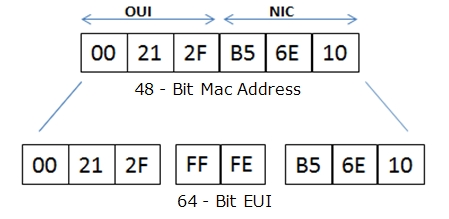
Next, the seventh bit from the left, or the universal/local (U/L) bit, needs to be inverted. This bit identifies whether this interface identifier is universally or locally administered. If 0, the address is locally administered and if 1, the address is globally unique. It is worth noticing that in the OUI portion, the globally unique addresses assigned by the IEEE has always been set to 0 whereas the locally created addresses has 1 configured. Therefore, when the bit is inverted, it maintains its original scope (global unique address is still global unique and vice versa). The reason for inverting can be found in RFC4291 section 2.5.1.
Reference:
https://supportforums.cisco.com/document/100566/understanding-ipv6-eui-64-bit-address
A
Extended Unique Identifier (EUI), as per RFC2373, allows a host to assign iteslf a unique 64-Bit IP Version 6 interface identifier (EUI-64). This feature is a key benefit over IPv4 as it eliminates the need of manual configuration or DHCP as in the world of IPv4. The IPv6 EUI-64 format address is obtained through the 48-bit
MAC address. The Mac address is first separated into two 24-bits, with one being OUI (Organizationally Unique Identifier) and the other being NIC specific. The
16-bit 0xFFFE is then inserted between these two 24-bits to for the 64-bit EUI address. IEEE has chosen FFFE as a reserved value which can only appear in EUI-
64 generated from the EUI-48 MAC address.
Here is an example showing how the Mac Address is used to generate EUI.

Next, the seventh bit from the left, or the universal/local (U/L) bit, needs to be inverted. This bit identifies whether this interface identifier is universally or locally administered. If 0, the address is locally administered and if 1, the address is globally unique. It is worth noticing that in the OUI portion, the globally unique addresses assigned by the IEEE has always been set to 0 whereas the locally created addresses has 1 configured. Therefore, when the bit is inverted, it maintains its original scope (global unique address is still global unique and vice versa). The reason for inverting can be found in RFC4291 section 2.5.1.
Reference:
https://supportforums.cisco.com/document/100566/understanding-ipv6-eui-64-bit-address
send
light_mode
delete
Question #23
For security purposes, an Ipv6 traffic filter was configured under various interfaces on the local router. However, shortly after implementing the traffic filter,
OSPFv3 neighbor adjacencies were lost. What caused this issue?
OSPFv3 neighbor adjacencies were lost. What caused this issue?
- AThe traffic filter is blocking all ICMPv6 traffic.
- BThe global anycast address must be added to the traffic filter to allow OSPFv3 to work properly.
- CThe link-local addresses that were used by OSPFv3 were explicitly denied, which caused the neighbor relationships to fail.
- DIpv6 traffic filtering can be implemented only on SVIs.
Correct Answer:
C
OSPFv3 uses link-local Ipv6 addresses for neighbor discovery and other features, so if any Ipv6 traffic filters are implemented be sure to include the link local address so that it is permitted in the filter list.
Reference:
http://www.cisco.com/c/en/us/td/docs/switches/datacenter/sw/5_x/nx-os/unicast/configuration/guide/l3_cli_nxos/l3_ospfv3.html
C
OSPFv3 uses link-local Ipv6 addresses for neighbor discovery and other features, so if any Ipv6 traffic filters are implemented be sure to include the link local address so that it is permitted in the filter list.
Reference:
http://www.cisco.com/c/en/us/td/docs/switches/datacenter/sw/5_x/nx-os/unicast/configuration/guide/l3_cli_nxos/l3_ospfv3.html
send
light_mode
delete
Question #24
What is the purpose of the autonomous-system {autonomous-system-number} command?
- AIt sets the EIGRP autonomous system number in a VRF.
- BIt sets the BGP autonomous system number in a VRF.
- CIt sets the global EIGRP autonomous system number.
- DIt sets the global BGP autonomous system number.
Correct Answer:
A
To configure the autonomous-system number for an Enhanced Interior Gateway Routing Protocol (EIGRP) routing process to run within a VPN routing and forwarding (VRF) instance, use the autonomous-system command in address-family configuration mode. To remove the autonomous-system for an EIGRP routing process from within a VPN VRF instance, use the no form of this command.
Autonomous-system -
no autonomous-system
Reference:
http://www.cisco.com/c/en/us/td/docs/ios/iproute_eigrp/command/reference/ire_book/ire_a1.html#wp1062796
A
To configure the autonomous-system number for an Enhanced Interior Gateway Routing Protocol (EIGRP) routing process to run within a VPN routing and forwarding (VRF) instance, use the autonomous-system command in address-family configuration mode. To remove the autonomous-system for an EIGRP routing process from within a VPN VRF instance, use the no form of this command.
Autonomous-system -
no autonomous-system
Reference:
http://www.cisco.com/c/en/us/td/docs/ios/iproute_eigrp/command/reference/ire_book/ire_a1.html#wp1062796
send
light_mode
delete
Question #25
What is the default OSPF hello interval on a Frame Relay point-to-point network?
- A10
- B20
- C30
- D40
Correct Answer:
A
Before you troubleshoot any OSPF neighbor-related issues on an NBMA network, it is important to remember that an NBMA network can be configured in these modes of operation with the ip ospf network command:
✑ Point-to-Point
✑ Point-to-Multipoint
✑ Broadcast
✑ NBMA
The Hello and Dead Intervals of each mode are described in this table:
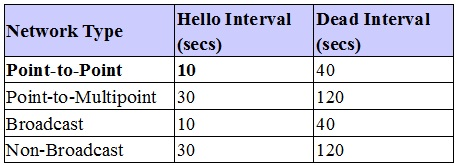
Reference:
http://www.cisco.com/c/en/us/support/docs/ip/open-shortest-path-first-ospf/13693-22.html
A
Before you troubleshoot any OSPF neighbor-related issues on an NBMA network, it is important to remember that an NBMA network can be configured in these modes of operation with the ip ospf network command:
✑ Point-to-Point
✑ Point-to-Multipoint
✑ Broadcast
✑ NBMA
The Hello and Dead Intervals of each mode are described in this table:

Reference:
http://www.cisco.com/c/en/us/support/docs/ip/open-shortest-path-first-ospf/13693-22.html
send
light_mode
delete
Question #26
Refer to the exhibit.
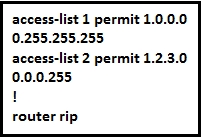
Which command only announces the 1.2.3.0/24 network out of FastEthernet 0/0?

Which command only announces the 1.2.3.0/24 network out of FastEthernet 0/0?
- Adistribute list 1 out
- Bdistribute list 1 out FastEthernet0/0
- Cdistribute list 2 out
- Ddistribute list 2 out FastEthernet0/0
Correct Answer:
D
Access list 2 is more specific, allowing only 1.2.3.0/24, whereas access list 1 permits all 1.0.0.0/8 networks. This question also asks us to apply this distribute list only to the outbound direction of the fast Ethernet 0/0 interface, so the correct command is "distribute list 2 out FastEthernet0/0."
D
Access list 2 is more specific, allowing only 1.2.3.0/24, whereas access list 1 permits all 1.0.0.0/8 networks. This question also asks us to apply this distribute list only to the outbound direction of the fast Ethernet 0/0 interface, so the correct command is "distribute list 2 out FastEthernet0/0."
send
light_mode
delete
Question #27
Which prefix is matched by the command ip prefix-list name permit 10.8.0.0/16 ge 24 le 24?
- A10.9.1.0/24
- B10.8.0.0/24
- C10.8.0.0/16
- D10.8.0.0/23
Correct Answer:
B
With prefix lists, the ge 24 term means greater than or equal to a /24 and the le 24 means less than or equal to /24, so only a /24 is both greater than or equal to
24 and less than or equal to 24. This translates to any prefix in the 10.8.x.0/24 network, where X is any value in the 0-255 range. Only the choice of 10.8.0.0.24 matches this.
B
With prefix lists, the ge 24 term means greater than or equal to a /24 and the le 24 means less than or equal to /24, so only a /24 is both greater than or equal to
24 and less than or equal to 24. This translates to any prefix in the 10.8.x.0/24 network, where X is any value in the 0-255 range. Only the choice of 10.8.0.0.24 matches this.
send
light_mode
delete
Question #28
Router A and Router B are configured with IPv6 addressing and basic routing capabilities using oSPFv3. The networks that are advertised from Router A do not show up in Router B's routing table. After debugging IPv6 packets, the message "not a router" is found in the output. Why is the routing information not being learned by Router B?
- AOSPFv3 timers were adjusted for fast convergence.
- BThe networks were not advertised properly under the OSPFv3 process.
- CAn IPv6 traffic filter is blocking the networks from being learned via the Router B interface that is connected to Router A.
- DIPv6 unicast routing is not enabled on Router A or Router B. D
Correct Answer:
Explanation
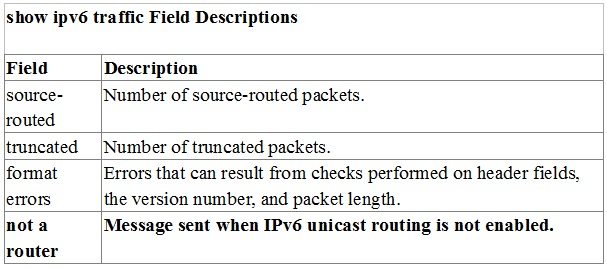
Reference:
http://www.cisco.com/c/en/us/td/docs/ios/ipv6/command/reference/ipv6_book/ipv6_16.html
Explanation

Reference:
http://www.cisco.com/c/en/us/td/docs/ios/ipv6/command/reference/ipv6_book/ipv6_16.html
send
light_mode
delete
Question #29
After you review the output of the command show ipv6 interface brief, you see that several IPv6 addresses have the 16-bit hexadecimal value of "fFFE" inserted into the address. Based on this information, what do you conclude about these IPv6 addresses?
- AIEEE EUI-64 was implemented when assigning IPv6 addresses on the device.
- BThe addresses were misconfigured and will not function as intended.
- CIPv6 addresses containing "FFFE" indicate that the address is reserved for multicast.
- DThe IPv6 universal/local flag (bit 7) was flipped.
- EIPv6 unicast forwarding was enabled, but IPv6 Cisco Express Forwarding was disabled.
Correct Answer:
A
Extended Unique Identifier (EUI), as per RFC2373, allows a host to assign iteslf a unique 64-Bit IP Version 6 interface identify them EUI-64). This feature is a key benefit over IPv4 as it eliminates the need of manual configuration or DHCP as in the world of IPv4. The IPv6 EUI-64 format address is obtained through the 48-bit
MAC address. The Mac address is first separated into two 24-bits, with one being OUI (Organizationally Unique Identifier) and the other being NIC specific. The
16-bit 0xFFFE is then inserted between these two 24-bits to for the 64-bit EUI address. IEEE has chosen FFFE as a reserved value which can only appear in
.
EUI-64 generated from the EUI-48 MAC address
Here is an example showing how the Mac Address is used to generate EUI.
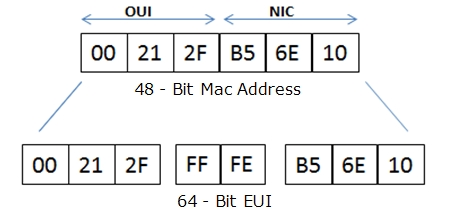
Next, the seventh bit from the left, or the universal/local (U/L) bit, needs to be inverted. This bit identifies whether this interface identifier is universally or locally administered. If 0, the address is locally administered and if 1, the address is globally unique. It is worth noticing that in the OUI portion, the globally unique addresses assigned by the IEEE have always been set to 0 whereas the locally created addresses have 1 configured. Therefore, when the bit is inverted, it maintains its original scope (global unique address is still global unique and vice versa). The reason for inverting can be found in RFC4291 section 2.5.1.
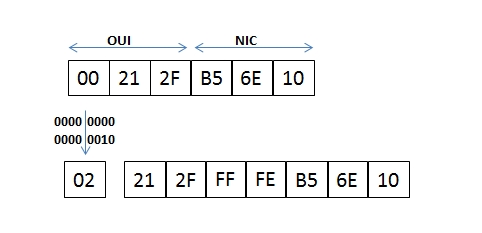
Once the above is done, we have a fully functional EUI-64 format address.
Reference:
https://supportforums.cisco.com/document/100566/understanding-ipv6-eui-64-bit-address
A
Extended Unique Identifier (EUI), as per RFC2373, allows a host to assign iteslf a unique 64-Bit IP Version 6 interface identify them EUI-64). This feature is a key benefit over IPv4 as it eliminates the need of manual configuration or DHCP as in the world of IPv4. The IPv6 EUI-64 format address is obtained through the 48-bit
MAC address. The Mac address is first separated into two 24-bits, with one being OUI (Organizationally Unique Identifier) and the other being NIC specific. The
16-bit 0xFFFE is then inserted between these two 24-bits to for the 64-bit EUI address. IEEE has chosen FFFE as a reserved value which can only appear in
.
EUI-64 generated from the EUI-48 MAC address
Here is an example showing how the Mac Address is used to generate EUI.

Next, the seventh bit from the left, or the universal/local (U/L) bit, needs to be inverted. This bit identifies whether this interface identifier is universally or locally administered. If 0, the address is locally administered and if 1, the address is globally unique. It is worth noticing that in the OUI portion, the globally unique addresses assigned by the IEEE have always been set to 0 whereas the locally created addresses have 1 configured. Therefore, when the bit is inverted, it maintains its original scope (global unique address is still global unique and vice versa). The reason for inverting can be found in RFC4291 section 2.5.1.

Once the above is done, we have a fully functional EUI-64 format address.
Reference:
https://supportforums.cisco.com/document/100566/understanding-ipv6-eui-64-bit-address
send
light_mode
delete
Question #30
A packet capture log indicates that several router solicitation messages were sent from a local host on the Ipv6 segment. What is the expected acknowledgment and its usage?
- ARouter acknowledgment messages will be forwarded upstream, where the DHCP server will allocate addresses to the local host.
- BRouters on the Ipv6 segment will respond with an advertisement that provides an external path from the local subnet, as well as certain data, such as prefix discovery.
- CDuplicate Address Detection will determine if any other local host is using the same Ipv6 address for communication with the Ipv6 routers on the segment.
- DAll local host traffic will be redirected to the router with the lowest ICMPv6 signature, which is statically defined by the network administrator.
Correct Answer:
B
Router Advertisements (RA) are sent in response to router solicitation messages. Router solicitation messages, which have a value of 133in the Type field of the
ICMP packet header, are sent by hosts at system startup so that the host can immediately autoconfigure without needing to wait for the next scheduled RA message. Given that router solicitation messages are usually sent by hosts at system startup (the host does not have a configured unicast address), the source address in router solicitation messages is usually the unspecified Ipv6 address (0:0:0:0:0:0:0:0). If the host has a configured unicast address, the unicast address of the interface sending the router solicitation message is used as the source address in the message. The destination address in router solicitation messages is the all-routers multicast address with a scope of the link. When an RA is sent in response to a router solicitation, the destination address in the RA message is the unicast address of the source of the router solicitation message.
RA messages typically include the following information:
"¢ One or more on link Ipv6 prefixes that nodes on the local link can use to automatically configure their Ipv6 addresses "¢ Lifetime information for each prefix included in the advertisement "¢ Sets of flags that indicate the type of autoconfiguration (stateless or stateful) that can be completed "¢ Default router information (whether the router sending the advertisement should be used as a default router and, if so, the amount of time (in seconds) the router should be used as a default router) "¢ Additional information for hosts, such as the hop limit and MTU a host should use in packets that it originates
B
Router Advertisements (RA) are sent in response to router solicitation messages. Router solicitation messages, which have a value of 133in the Type field of the
ICMP packet header, are sent by hosts at system startup so that the host can immediately autoconfigure without needing to wait for the next scheduled RA message. Given that router solicitation messages are usually sent by hosts at system startup (the host does not have a configured unicast address), the source address in router solicitation messages is usually the unspecified Ipv6 address (0:0:0:0:0:0:0:0). If the host has a configured unicast address, the unicast address of the interface sending the router solicitation message is used as the source address in the message. The destination address in router solicitation messages is the all-routers multicast address with a scope of the link. When an RA is sent in response to a router solicitation, the destination address in the RA message is the unicast address of the source of the router solicitation message.
RA messages typically include the following information:
"¢ One or more on link Ipv6 prefixes that nodes on the local link can use to automatically configure their Ipv6 addresses "¢ Lifetime information for each prefix included in the advertisement "¢ Sets of flags that indicate the type of autoconfiguration (stateless or stateful) that can be completed "¢ Default router information (whether the router sending the advertisement should be used as a default router and, if so, the amount of time (in seconds) the router should be used as a default router) "¢ Additional information for hosts, such as the hop limit and MTU a host should use in packets that it originates
send
light_mode
delete
All Pages
